nForce 500: nForce4 on Steroids?
by Gary Key & Wesley Fink on May 24, 2006 8:00 AM EST- Posted in
- CPUs
Synthetic Graphics Performance
The 3DMark series of benchmarks developed and provided by Futuremark are among the most widely used tools for benchmark reporting and comparisons. Although the benchmarks are very useful for providing apples-to-apples comparisons across a broad array of GPU and CPU configurations, they are not a substitute for actual application and gaming benchmarks. In this sense we consider the 3DMark benchmarks to be purely synthetic in nature but still valuable for providing consistent measurements of performance.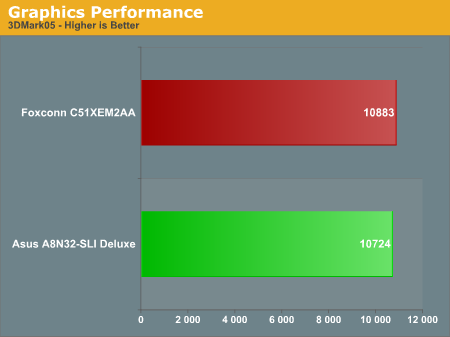
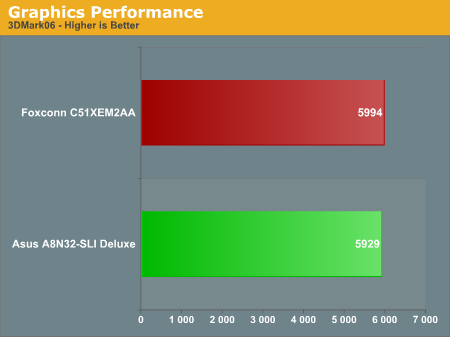
Our nForce 590 SLI system improves upon the performance of the nForce4 system by an average of 1%. These test results are basically a tie and indicates both platforms are performing equally with the same video card.
General System Performance
The PCMark05 benchmark developed and provided by Futuremark was designed for determining overall system performance for the typical home computing user. This tool provides both system and component level benchmarking results utilizing subsets of real world applications or programs. This benchmark is useful for providing comparative results across a broad array of Graphics subsystems, CPU, Hard Disk, and Memory configurations along with multithreading results. In this sense we consider the PCMark benchmark to be both synthetic and real world in nature while providing consistency in our benchmark results.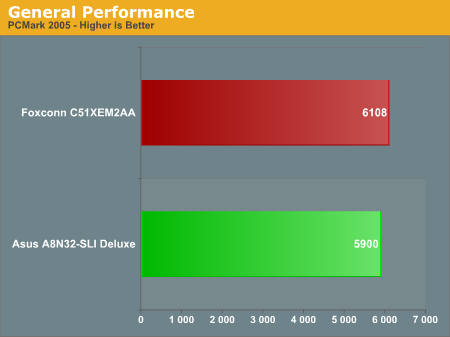
The margins are little wider at 4% in the PCMark05 results, but the margin of error in PCMark05 is also slightly larger. It is obvious from our test results so far that either platform provides excellent results. If you have a socket 939 platform and are happy with its feature set then we do not see a reason to upgrade at this time.
Rendering Performance
We have added the Cinebench 9.5 and POV-RAY 3.6 benchmarks as they heavily stress the CPU subsystem while performing graphics modeling and rendering. We utilize the standard benchmark demos in each program along with the default settings. Cinebench 9.5 features two different benchmarks with one test utilizing a single core and the second test showcasing the power of multiple cores in rendering the benchmark image.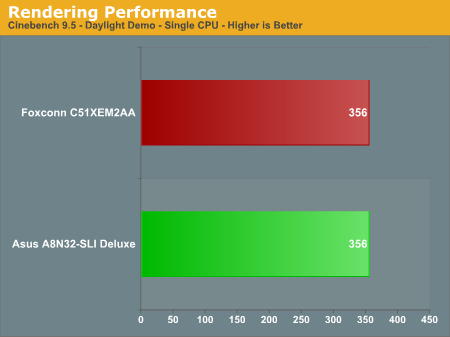
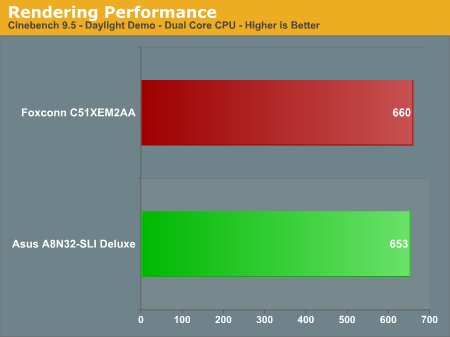
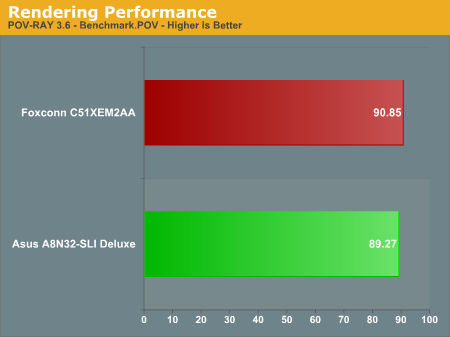
The nForce 500 desktop platform shows small and almost imperceptible differences in these benchmarks, with the 590 AM2 performing slightly better in the demanding POV-RAY benchmark. Once again both platforms are performing equally.










64 Comments
View All Comments
Googer - Wednesday, May 24, 2006 - link
http://www.hardwarezone.com/news/view.php?id=4614&...">http://www.hardwarezone.com/news/view.php?id=4614&...http://www.neoseeker.com/Articles/Hardware/Reviews...">http://www.neoseeker.com/Articles/Hardware/Reviews...
Googer - Wednesday, May 24, 2006 - link
AM2 Now Shiping at Newegg.comhttp://www.newegg.com/Product/ProductList.asp?Subm...">http://www.newegg.com/Product/ProductLi...rchInDes...
Doormat - Wednesday, May 24, 2006 - link
The media shield feature looks nice. Buy two drives for a RAID-0 array for the OS and whatnot. Then the RAID-5 array for all your important stuff (saved games, documents, pictures, etc). Having both arrays on one chipset is nice.Pirks - Wednesday, May 24, 2006 - link
Why would you penalize your write speed with RAID5 when there is RAID1? Why not get RAID1 instead of RAID5 and enjoy 1) reliability (same as RAID5) 2) speed (same as single drive for writing, faster than single drive for reading) 3) low price (no need for more than two hard drives)mino - Wednesday, May 24, 2006 - link
AND lower available capacity for the money you pay. You see 4 300G drives in RAID5 bring you 900GB of (cheap and reliable) storage. Do that with 4 drives and RAID1(or 0+1 for that) means i.e. 2x400 + 2x500 which is SIGNIFICANTLY more expensive.Remember there are guys with 10 drives, any situation you could economically justify 3+ drives for storage RAID5 is the most cost effective way.
JarredWalton - Thursday, May 25, 2006 - link
Too bad the integrated RAID 5 solutions from NVIDIA only work with 3 drives (and potentially one hot-swap). Maybe I'm mistaken, but I'm pretty sure you can't run 4, 5, or 6 drives in a single RAID 5 array using the NVIDIA controller. That's why you can do two RAID 5 arrays with 3 drives in each array. Problem is, doing RAID 5 without a lot of RAM for the RAID controller can really hurt (write) performance.nordicpc - Wednesday, May 24, 2006 - link
Something I noticed yesterday while looking through the AM2 reviews that incorporated both ATI and nVidia's chipsets was the huge disparency in power usage, some 40 watts in some cases.Charlie D. has brought this up over at the Inq aswell.
Not only with nVidia's 5x0 series do you need a huge chunk of copper with 3 pipes to eliminate the fan, but also you'll be paying a bit extra on the power bill it seems, for what? Some extra networking options that most of us never use because they are so dodgy.
Where's the power consumption page on here?
Gary Key - Wednesday, May 24, 2006 - link
They are coming in a different article as we just started receiving our ATI AM2, nF550, and other boards. The pull in by AMD was a stretch for the board suppliers who had planned on rolling the AM2 series out during Computex and shipping at that time. NVIDIA was caught trying to qualify drivers for both the video and platform side in half the time. We just received final AM2 chips on Saturday morning. ;-)
NullSubroutine - Wednesday, May 24, 2006 - link
mehfitten - Wednesday, May 24, 2006 - link
I concurr.